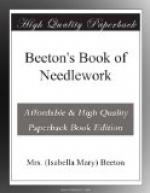[Illustration: 505.—Point de Toile.]
* * * * *
POINT DE FESTON is worked by a series of overcast stitches, as seen by illustration 506, which clearly shows the manner of working. The frame is turned at each stitch, the stitches are taken across the squares, and increase in length at the top of the square.
[Illustration: 506.—Point de Feston.]
* * * * *
POINT DE REPRISE, or DARNING, is worked by stretching 2 or 3 threads over 1, or 2, or more squares. The thread is darned over and under, and the needle used to arrange the last stitch while passing through to form the next. This stitch is very easily acquired. It is always worked with coarser thread than the foundation; No. 2 thread should be employed for a coarse groundwork. No. 510 shows this stitch used to form stars, figures, &c.
[Illustration: 507—Point de Reprise.]
[Illustration: 508.—Leaf.]
* * * * *
POINT DE BRUXELLES, as shown on pages 506 and 507, is a kind of loose button-hole stitch, and is used for forming various patterns and for filling up squares. It also forms “leaves,” when the number of stitches is decreased each row until the leaf finishes off in a point. Nos. 509 and 510 clearly show this stitch.
[Illustration: 509.—Point de Bruxelles.]
[Illustration: 510.—Point de Bruxelles.]
* * * * *
WHEELS are easy to work, and are begun in the centre. Four threads are taken across, as shown in design No. 511; the thread is twisted in bringing it back to the centre, and the wheel formed by passing the thread under and over the netting and the crossing threads. It is fastened off on the back of the several wheels.
[Illustration: 511.—Wheel (commenced).]
[Illustration: 512.—Wheel.]
Wheel No. 513 is a square wheel, and is worked in the same manner, with the addition of point d’esprit loops, through which, and under and over the cross-twisted threads, 4 or 5 rows of thread are passed.
[Illustration: 513.—Square Wheel.]
[Illustration: 514.—Wheel larger than its real size.]
* * * * *
STARS are of various form, as shown in Nos. 516, 517, 518, 519, and 520.
No. 516 is worked in point de feston (see page 507) round a single square hole, which is filled in by a small wheel or rosette.
No. 517 is worked in point de feston and point de Bruxelles, alternately round a centre simply crossed by point d’esprit threads.
[Illustration: 516.—Star.]
No. 518 is more elaborate, and is worked thus:—Begin at the place marked a; twist the linen thread 3 times round the nearest thread, draw it on to the knot b; repeat this 3 times, following the order of the letters; twist the linen thread also between the threads, as can be seen from the illustration, and fasten it underneath the knot a; for the wheel fasten on the cotton afresh and work the remaining pattern in darning stitch (point de reprise).




